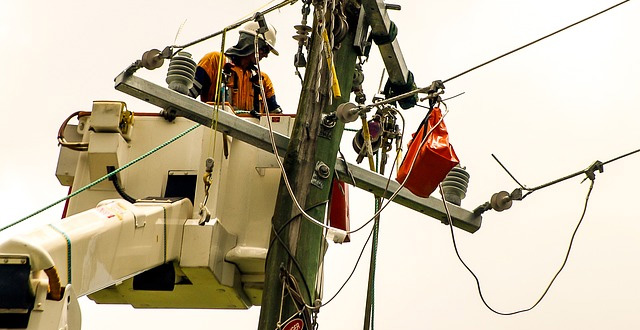Cherry picker
Contents |
[edit] Introduction
Cherry pickers are pieces of machinery easily identified by their long, extendible arm (or boom) with a cradle attached on the end. They are also known as telehandlers, telescopic handlers, and boom lifts.
Cherry pickers can be moved, and are versatile, with a boom able to extend forwards and upwards. Several different attachments can be fitted to the end of the boom, such as a cradle, bucket, pallet forks, muck grab, winch, and so on.
[edit] Uses
They are multi-purpose and flexible, ideal for any job that requires the user to work at height, in particular, in awkward locations.
[edit] Fruit picking
The name 'cherry picker' is derived from their original purpose - to help people pick cherries. It is still possible to find them being used in fruit orchards, helping to get the hard to reach fruit at the tops of trees and in difficult to reach locations.
These machines revolutionised how people could pick fruit and ensured the best fruit could always be picked in safe manner – with no danger of falling. They have also made the process of picking fruit more efficient through time savings and the reduced risk of losing fruit to falls.
Other uses of cherry pickers include:
[edit] Construction
Cherry pickers can be used to gain access to upper floors of construction works without needing to erect scaffolding or use cranes. Their mobility and flexibility means that they can give rapid access to a number of different locations.
[edit] Telegraph poles
Cherry pickers allow engineers to reach the top of telegraph poles to either inspect or repair cabling. This highly-skilled job has been made much less dangerous and complex by the use of cherry pickers. Previously, engineers had to ascend the poles a ladder, or by climbing them. Now they can reach the top in the relative safety of the cherry picker’s cradle with space for their tools and for multiple engineers.
[edit] Cleaning
Maintenance of building facades is very important, but can be difficult due to height, difficult shapes and poor access. Cherry pickers have made the process of cleaning and maintaining the more difficult-to-reach, lower parts properties easier and safer. Workers no longer need to use ladders or scaffolding whilst carrying tools, buckets and other equipment.
[edit] Fire and Rescue Service
The fire and rescue service can use cherry pickers to fight fires and save lives. They allow them to reach the higher floors of buildings and create a safe platform to step onto to reach safety.
[edit] Filming
Cherry pickers can be used for shots that require an elevated angle above a scene. Cameras can be mounted directly onto a cherry picker and remotely controlled to give sweeping aerial shots.
[edit] Related articles on Designing Buildings
- Back actor.
- Bituminous mixing and laying plant.
- CDM.
- Compressed air plant.
- Concreting plant.
- Crane regulations.
- Construction plant.
- Construction tools.
- Crane supports.
- Earth-moving plant.
- Excavating plant.
- Forklift truck.
- Lift table.
- Lifting device.
- Mobile elevating work platforms (MEWPs).
- Pallet jack.
- Power float.
- Scaffolding.
- Scissor lift.
- Stacker.
- Temporary works.
- Types of crane.
- Work at height regulations.
Featured articles and news
How big is the problem and what can we do to mitigate the effects?
Overheating guidance and tools for building designers
A number of cool guides to help with the heat.
The UK's Modern Industrial Strategy: A 10 year plan
Previous consultation criticism, current key elements and general support with some persisting reservations.
Building Safety Regulator reforms
New roles, new staff and a new fast track service pave the way for a single construction regulator.
Architectural Technologist CPDs and Communications
CIAT CPD… and how you can do it!
Cooling centres and cool spaces
Managing extreme heat in cities by directing the public to places for heat stress relief and water sources.
Winter gardens: A brief history and warm variations
Extending the season with glass in different forms and terms.
Restoring Great Yarmouth's Winter Gardens
Transforming one of the least sustainable constructions imaginable.
Construction Skills Mission Board launch sector drive
Newly formed government and industry collaboration set strategy for recruiting an additional 100,000 construction workers a year.
New Architects Code comes into effect in September 2025
ARB Architects Code of Conduct and Practice available with ongoing consultation regarding guidance.
Welsh Skills Body (Medr) launches ambitious plan
The new skills body brings together funding and regulation of tertiary education and research for the devolved nation.
Paul Gandy FCIOB announced as next CIOB President
Former Tilbury Douglas CEO takes helm.
UK Infrastructure: A 10 Year Strategy. In brief with reactions
With the National Infrastructure and Service Transformation Authority (NISTA).
Ebenezer Howard: inventor of the garden city. Book review.
The Grenfell Tower fire, eight years on
A time to pause and reflect as Dubai tower block fire reported just before anniversary.
Airtightness Topic Guide BSRIA TG 27/2025
Explaining the basics of airtightness, what it is, why it's important, when it's required and how it's carried out.
Construction contract awards hit lowest point of 2025
Plummeting for second consecutive month, intensifying concerns for housing and infrastructure goals.
Understanding Mental Health in the Built Environment 2025
Examining the state of mental health in construction, shedding light on levels of stress, anxiety and depression.

























Comments